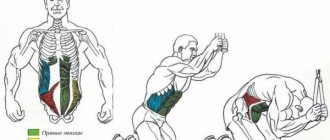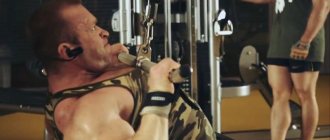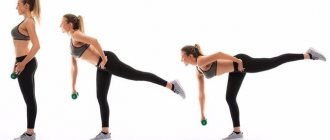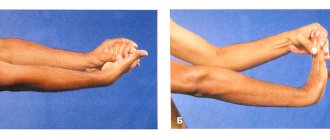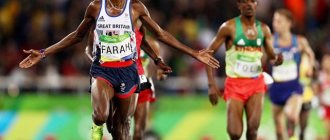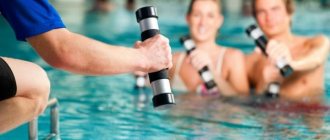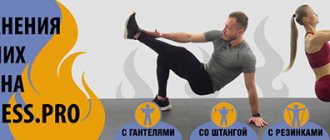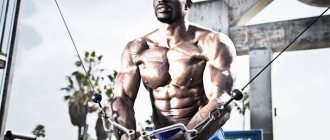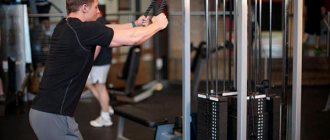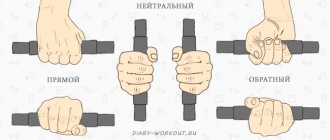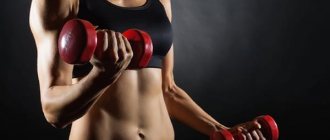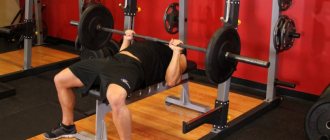Shaped hands are a calling card and an indicator of excellent physical shape in men. Girls are also not averse to “putting things in order” in this area: the lack of muscle tone here spoils the impression even with well-developed buttocks and abs. Effective training of the arms, including triceps, along with basic exercises, should also include isolating movements, for example, extensions on a block.
- Extension of arms on a block: what is the essence of the exercise
- Which muscles get the load?
- The benefits of extensions on the block
- Variability of arm extensions on a block: types of handles
- Classification of standing exercise: extension on a block in different versions
- Classic arm extensions using a lat pulley
- Reverse grip extensions
- Triceps pull-down using a rope handle
- Video: Technique of arm extensions on a vertical (also on the lower) block using different types of handles and grips
- Arm extensions downwards on a block: common mistakes
- How to increase the effectiveness of the triceps crossover press: recommendations
- Video: Triceps superset using extension on a vertical block - execution
Muscles involved in the exercise
- Biceps brachii (biceps). In this case, it does the main work, and both heads of the biceps are involved.
- The brachialis (also known as the brachialis muscle) is a muscle located deeper, that is, under the biceps. Despite the fact that the brachialis takes maximum part only at the beginning of flexion, this load is quite sufficient to ensure its growth. A well-developed brachialis visually emphasizes the volume of the biceps, since it seems to push the biceps, increasing it.
- The forearm muscles are also partially loaded when bending the arms in a crossover. In particular, the brachioradialis muscles and pronator teres muscles work - they assist in bending the arms.
Common mistakes
Bending of the wrists.
Keep your elbows and bones level. Wrist curls will increase the load on the wrist and additionally recruit the latissimus dorsi muscles to perform the exercise. The level of load on the triceps will decrease, and the exercise will lose its effectiveness.
Straight body.
Fixing the body in its original position using the abdominal muscles and latissimus dorsi or stooping contributes to the development of spinal problems.
Small distance to block.
The weight will be pulled upward, and the exercise will require moving your elbows back. The load is redistributed to other muscles, and posture is also disrupted.
The block is too far.
Excessive forward bending will strain the lower back.
The head is lowered or looking to the side.
Keep your head strictly straight, this promotes normal posture and body position.
Progression of loads
We figured out what exercises pump the triceps. However, no set of exercises will give the desired result if you do not improve your performance at each workout.
There are several ways to do this:
- Increasing working weights. The method is fundamentally important for basic exercises, but for isolation it is advisable to gradually increase the weight used - of course, without sacrificing technique. This is done like this: you did 3 sets of bench press with a narrow grip with a weight of 80 kg for 10 repetitions. For your next workout, try lifting a weight of 82.5 kg. Most likely, you won’t be able to do 10 reps in all sets, but it will come out to about 10-8-6. Continue with this weight until you can do 10-10-10. After this, increase the working weight by another 2.5 kg.
- Increasing the number of repetitions. Let's say you were able to do 3 sets of strict barbell French presses for 12 reps. Weight does not play a role in this case. In your next workout, try to do 13 repetitions without compromising your technique or increasing the rest time between sets. Next time - 14, then - 15. After that, slightly increase the weight of the barbell, drop again to 12 repetitions and repeat all over again.
- Increasing the number of approaches. When you can easily complete 3 sets of any triceps exercise, do another set. The number of repetitions and rest time remain the same. Increasing your training volume (within reasonable limits) is a powerful stimulus for growth.
- Adding new exercises. This technique is only suitable for experienced athletes. If you feel that three or four exercises are no longer enough to properly pump up your triceps, add one more exercise to your program. Start with light isolation, and if this is not enough, complete the arm workout with a French bench press with a barbell or dips with additional weight. Painful sensations are guaranteed the next day.
- Reducing rest time between sets. It will be difficult at first, but with experience your muscles will become more resilient: you will not lose productivity using minimal rest time. The blood supply to the muscles will be much stronger.
- Increasing the number of workouts. This option will help athletes whose arm muscles stubbornly refuse to grow. There are many reasons for stagnation, but in most cases, more frequent and intense training successfully solves the problem. Train your triceps twice a week: the first time with your chest, the second time with your biceps. You can do lighter workouts in supersets to achieve maximum pump. This should help you build up your arms.
What to replace at home
There are a number of triceps exercises you can do at home. The most popular of them are the overhead press using dumbbells with either one or two hands, the bench press with a close grip, the French press with weights. However, only the first of them is isolated.
You can try to make something similar to a vertical block using available materials.
To do this you need:
- Take a tight rubber about two meters long.
- Fold in half and secure at the ends - for example, on a wall bars.
- Sew up the middle with thread so that the bar, located as in a simulator, fits there; it should be at the height of your bent elbows.
- Next, perform the exercise in the same way as in the gym. Rubber tension will replace weight.
Triceps exercises need to be given due attention, because the relief, and therefore the beauty of your arms, depends on it. This is especially necessary for the fair sex. It is better to perform it in the gym, as a final refinement of the muscles of this group.
Triceps Exercises Arms Sports and fitness Strength training Exercises on machines Crossover
Arm extension on the upper block
Hello to all visitors and regular readers of the MusclesFit body development blog. ru. Today I decided to tell you about a very interesting and useful exercise that is aimed at developing the extensor of the arm, or, more simply, the triceps. It's called Arm Extension on the Upper Block. and, it would seem, it’s already clear from the name how to do it.
But that’s not the case, like any other exercise, extension on a block has a number of nuances that you need to know if you want to pump up your triceps as much as possible and not waste precious energy.
From a technical point of view, arm extension on the upper block is a fairly simple exercise; it will take relatively little time to master. The main thing is to take the right position and choose the best grip for yourself. So, let's start describing the technique.
Extension on the block. Technique
We are all accustomed to the fact that for each individual exercise there is one, maximum two correct starting positions.
In the case of triceps extension, there is no specific correct position. The point is that the optimal position may be different for me and for you.
For example, I find it more comfortable when I am a little further from the vertical of the cable and it approaches me at an angle, but this does not mean that this position is suitable for everyone.
The main thing to remember is that the correct body position in this exercise is to completely fix it, with the exception of the elbow joints. This means that during the approach, the body must be motionless; Only the elbows work. No rocking or assistance with the lower back or shoulders is allowed. This seriously affects efficiency, which in some cases can drop to zero.
The main principle of the exercise is that movement occurs only in the elbow joint.
Now let's move on to the grips.
It’s worth saying right away that we are considering extension of the arms on the upper block with a straight handle. When you perform this exercise with an overhand grip, you train the outer and middle triceps.
It is these “guys” who are responsible for the volume of the arm from the outside. Therefore, if you are not chasing ideal proportions, then it will be sufficient to perform triceps extensions with a straight overhand grip.
If half measures are not your thing, then you need to pay attention to the internal triceps bundle, which often receives less load and lags behind in many athletes. To use this part of the triceps muscle of the shoulder, you just need to change your grip by holding the handle with a pronated grip, that is, an underhand grip in which your palms will be pointing up
To engage this part of the triceps muscle, you just need to change your grip by holding the handle with a pronated grip, that is, an underhand grip, with your palms facing up.
These were the two main nuances that directly affect the overall effectiveness of the exercise. Keeping them in mind, the athlete will be able to perform extensions on the block in various variations and at the same time direct the entire load where it is needed.
Now, let's look at the algorithm for performing arm extension on the upper block step by step. So, the first thing to do is grab the handle with both hands and pull the weight towards the middle of your chest - this will be the starting point for this exercise.
Next, you need to lean forward a little, press your elbows to your body and fix your body to prevent any swaying during the exercise. Having taken the required position, lower the handle down until your arms are fully straightened. There is no need to leave a bend in the elbows, otherwise the triceps will not fully contract. At the bottom point, pause for a second and return to the starting position. Next, repeat this movement 8-12 times.
Don't forget about breathing. As always, exhalation occurs with effort, and inhalation must be done during the negative phase, in this case, when you return the handle to its original position.
To summarize, it is also worth saying that arm extension on the upper block is best done in the final phase of training, when all the heavy basic exercises have been completed.
Recommendations for performing the exercise
During arm extensions on a block, it is easy to make a fairly large number of mistakes. Thus, the target muscle group does not receive proper tension. Try to work technically correctly.- Press your elbows tightly to your torso. The purpose of the exercise is to pump up the triceps, not the back.
- There is no need to additionally work with your hands; the load on your wrists should be minimal.
- Watch the position of your back, do not perform movements in a large tilt. Try not to slouch.
- Do not perform arm extensions on a block while sitting.
- The gaze must be directed forward. Try to follow your movements in the reflection. You can only turn your head if the mirror is on your side.
- Work only with the help of triceps forces, do not pull the handle with your back. The latissimus muscles should remain in a static position.
- Before each lesson you need to warm up well. This way you can prepare your joints and ligaments for more difficult work.
- Do not exercise with a pulley machine if your elbows hurt. The athlete needs to fully recover to prevent relapse. If you experience pain in your wrists, you can use a special brace. If you are still in pain and uncomfortable, see your doctor.
- Do not exercise immediately after the cast is removed. At first, work with only light sports equipment.
Crossover Curl
The crossover curl is an isolation exercise aimed at developing the biceps muscles. The exercise helps to form the so-called “peak” of the biceps, which gives the biceps a high middle part and an expressive appearance.
Muscles involved in the exercise
- Biceps brachii (biceps). In this case, it does the main work, and both heads of the biceps are involved.
- The brachialis (also known as the brachialis muscle) is a muscle located deeper, that is, under the biceps. Despite the fact that the brachialis takes maximum part only at the beginning of flexion, this load is quite sufficient to ensure its growth. A well-developed brachialis visually emphasizes the volume of the biceps, since it seems to push the biceps, increasing it.
- The forearm muscles are also partially loaded when bending the arms in a crossover. In particular, the brachioradialis muscles and pronator teres muscles work - they assist in bending the arms.
Technique:
In the concentrated phase, we bring our hands to approximately the middle of your head, as if we were doing an ear pull. All movements are smooth, concentrate on working your biceps. This is a great exercise that will add variety to your training process.
- To begin, attach two handles to the top blocks in the crossover and set the weight you will be working with on each side of the crossover. Note: Make sure the same weight is installed on each side of the crossover.
- Next, adjust the height of the blocks on each side, making sure they are higher than your shoulders.
- Stand in the middle, grab the handles attached to the cables of the machine with each hand, use a grip on the handles with your palms facing the ceiling. Your arms should be straight and parallel to the floor, your feet should be shoulder-width apart. The arms are symmetrical when performed on both sides.
- At this time, as you exhale, slowly bend your arms, contracting your biceps muscles, until your forearms come closer to your biceps, bringing your arms approximately to the area of your head.
- Next, while inhaling, move your forearms back to the starting position. Note: The entire body is stationary during this exercise. The movement is performed only in the forearms.
- Repeat the movements for the number of repetitions specified in your program.
Tips for implementation
- When extending your arms, keep them slightly bent so as not to put excessive stress on your elbow joints.
- Since the exercise is an isolating exercise and is aimed mainly at giving relief to the biceps muscles, it is not recommended to use excessive working weight when performing it. Heavy weight will not allow you to concentrate on the correct technique.
- Also due to the fact that the exercise is isolated, it is better to use a fairly large number of repetitions: 12 - 16.
- When performing, all movements are performed smoothly and under control, feeling the contractions and work of the biceps.
- Throughout the entire movement, the body remains motionless, as does the whole body. The gaze is directed straight ahead.
- For a more effective load, you can hold for 1 second at the moment when the biceps are contracted to the maximum, this will allow you to additionally load the biceps.
- Some block simulators do not have the ability to adjust the height of the cables. If you have to raise your arms too high when performing, you should use some kind of stand, for example, a step platform.
Execution options
This exercise can also be performed with each arm alternately using one handle of the overhead pulley.
Video: Curling arms in a crossover:
https://youtube.com/watch?v=zK_bT579qNk
This is interesting: Concentrated bending: consider in detail
Basic triceps exercises
When performing a set of basic exercises, not only the triceps work, but also other muscle groups. We are talking about the chest and shoulders.
During the bench press, the upper triceps, anterior deltoids and upper chest muscles are intensively worked.
Advice! For beginners, it is better to give preference to the EZ bar - it makes it easier to fix the position.
During the exercise, all areas of the triceps are worked out. The main emphasis is on the lateral head.
Advice! For beginners, you can place your palms on the bench a little wider - this makes it easier to fix the elbow joints.
When performing the exercise, the pectoral muscles, deltoids and triceps are tensed, which we extend the limb at the elbow.
Advice! To isolate the muscle as much as possible, you should bring your elbows closer to your body and do not spread them to the sides throughout the entire exercise.
How to pump up triceps and why you need it
The triceps consists of three heads: long, medial and lateral. Together they form the triceps horseshoe. This muscle union received its name due to its external resemblance to an ordinary horseshoe. The vast majority of novice bodybuilders ignore triceps training because they believe that the aesthetic beauty of the arm depends only on the biceps. In fact, this is a deep misconception.
With a well-developed triceps, it will separate from the deltoid muscle, and you will get a truly beautiful arm. By developing only one biceps, you destroy the entire balance of the muscles. This results in the appearance of your hands being out of proportion. Think about it. In this article we will look at almost all triceps exercises. If you are interested in beautifully balanced arm muscles, read on.
First, I would like to destroy a couple of myths. Unfortunately, most bodybuilding literature is filled with false information. According to incorrect articles, there are triceps exercises that work each head individually. In practice, everything is different. Any arm extension uses all three heads of the triceps. But! Depending on the angle of execution, the handle, or the trajectory, you shift most of the load to a specific triceps head
It's important to remember that bodybuilding often depends on your genetic makeup. The shape of the triceps is genetically inherent in you, you can only increase the volume
By the way, if you have a weak and invisible lateral head, it will be quite difficult for you to tighten it to the size of the other two.
We create a high-quality training program
Take into account your individual characteristics in order to create a high-quality lesson plan. Regular triceps extensions on a block will not be enough. You will not be able to properly pump this muscle group.
Bodybuilders most often do a split program. During one session, several muscle sections are worked at once. Many men and women combine triceps and chest training. An effective training plan may consist of the following sports elements.
| Exercise name | Muscle groups involved | Number of repetitions | Notes |
| Dips | Pectoralis major, triceps muscle | Maximum number of times | Performed at the end of the warm-up. An alternative exercise is push-ups. |
| Bench press | Pectoralis major, triceps, deltoids | 10 -12 | Do 3-4 working sets. You can also exercise with dumbbells. |
| Lying dumbbell raises | Upper chest | 8-10 | You need to work at a slow pace. Perform the exercise on a horizontal bench. |
| French press | Triceps | 8-10 | Exercise with dumbbells or barbells. Work through the efforts of the triceps. |
| Extension of arms on a block | Triceps | 10 -12 | There are several variations of the movements, use different handles. |
As we can see, the triceps take an active part in pumping the pectoral muscles. Heavy compound exercises help increase overall lean body mass.
You should not perform arm extensions on the block very often. It is enough to pump your triceps once a week. This way, the muscles will recover well between classes. You can avoid the effect of overtraining. Within a few weeks of starting the training, you will notice real changes. Your triceps will become much bigger and more defined!
Extension of arms on a block is performed in a special simulator - “Crossover”, which is present in every gym. Depending on the grips and handles, you can effectively work each triceps bundle, isolated from the rest of the muscles. Everyone can choose exercise options for themselves - beginners and professionals.
Alternative Exercises
As a compromise to this exercise, another, no less technically complex exercise can be used - extension of the arm with a dumbbell from behind the head in a standing position. It is more effective than training with dumbbells while lying on a bench and is performed as follows:
- Stand up straight.
- Place your hand with a dumbbell behind your head (your wrist should remain in its natural position).
- Bend your elbow and place your hand and dumbbell behind your head, while maintaining the position of your elbow.
- After a 2-second delay, you can straighten your arm, returning to the starting position.
As in previous cases, flexion is performed while inhaling, and extension is performed while exhaling.
When performing this exercise, it is important to keep your core still. When lowering your wrist with the dumbbell down (bringing it behind your head), you need to keep your back straight to avoid arching your lower back
A similar exercise can be performed lying down or sitting on a bench with a short back. In this case, it can be done with both hands, simultaneously holding a dumbbell, barbell or W-shaped bar.
Since this training is technically and physically difficult, it is better to conduct it together with an assistant who could control the reproduction technique and provide backup.
Another alternative to block training is an exercise to work the same muscle groups, performed while bending over or resting on a bench. Unlike bench barbell extensions (French press), these variations allow more use of the long head of the triceps. To train your arm muscles from a bent-over position, it is enough to sit in a stable position with your knees slightly bent and your torso slightly bent forward. At the same time, you should keep your back straight and tilted, and you can lean on your leg with your non-working hand. We bend our working arm at the elbow, holding the dumbbell at an angle of 90⁰. As you inhale, perform extension and as you exhale, perform flexion.
To do the same, but not in an inclined position, but with support on the bench, it is enough to lean on it with your non-working hand and place one knee on the bench. Then also do the exercise, performing extension while inhaling and flexion while exhaling.
When starting to work out the arm muscles on the block, you need to first determine your final goals. This will help you correctly calculate the weight and choose the most optimal handle option. For example, extensions with a rope will help to work the triceps as deeply as possible, and when using other handles, you can pump the triceps brachii muscle from different angles.
The benefits of exercise using a block machine
Triceps extensions are one of the most effective exercises that are often performed by both men and women. You can pump up the target muscle group in isolation, thanks to working in a crossover (block simulator). You will achieve the following goals:
- Increase your triceps strength.
- You will purposefully pump the triceps brachii muscle.
- Increase the volume of your arms and make them more toned. Excess fat deposits will simply burn off.
- Strength in heavy compound movements (such as bench press and deadlift) will increase several times.
It is very important to perform all movements technically correctly. Before class, warm up the desired muscle groups well.
Execution technique
In the concentrated phase, we bring our hands to approximately the middle of your head, as if we were doing an ear pull. All movements are smooth, concentrate on working your biceps. This is a great exercise that will add variety to your training process.
- To begin, attach two handles to the top blocks in the crossover and set the weight you will be working with on each side of the crossover. Note: Make sure the same weight is installed on each side of the crossover.
- Next, adjust the height of the blocks on each side, making sure they are higher than your shoulders.
- Stand in the middle, grab the handles attached to the cables of the machine with each hand, use a grip on the handles with your palms facing the ceiling. Your arms should be straight and parallel to the floor, your feet should be shoulder-width apart. The arms are symmetrical when performed on both sides.
- At this time, as you exhale, slowly bend your arms, contracting your biceps muscles, until your forearms come closer to your biceps, bringing your arms approximately to the area of your head.
- Next, while inhaling, move your forearms back to the starting position. Note: The entire body is stationary during this exercise. The movement is performed only in the forearms.
- Repeat the movements for the number of repetitions specified in your program.
Tips for implementation
- When extending your arms, keep them slightly bent so as not to put excessive stress on your elbow joints.
- Since the exercise is an isolating exercise and is aimed mainly at giving relief to the biceps muscles, it is not recommended to use excessive working weight when performing it. Heavy weight will not allow you to concentrate on the correct technique.
- Also due to the fact that the exercise is isolated, it is better to use a fairly large number of repetitions: 12 - 16.
- When performing, all movements are performed smoothly and under control, feeling the contractions and work of the biceps.
- Throughout the entire movement, the body remains motionless, as does the whole body. The gaze is directed straight ahead.
- For a more effective load, you can hold for 1 second at the moment when the biceps are contracted to the maximum, this will allow you to additionally load the biceps.
- Some block simulators do not have the ability to adjust the height of the cables. If you have to raise your arms too high when performing, you should use some kind of stand, for example, a step platform.
Advantages and disadvantages of the exercise
Advantages
- This exercise will allow you to work all three heads of the triceps in isolation.
- To perform, only one dumbbell is enough, and not a lot of weight. Therefore, it can be easily done at home.
- Very little risk of injury. Of course, when working with the right weight and good technique.
- Great for girls. Because they just want to shape their arms without increasing the size of their triceps.
- It will help eliminate imbalances in the development of each arm.
- The technique is easy to master. So you don’t have to spend months practicing the movement.
- It will help you finish off your triceps at the end of your workout.
Flaws:
- It is impossible to build muscle mass with bent over arm extensions. Since the weight of dumbbells is not large. Therefore, it is not suitable for beginners. At first, it is best to give preference to PUSH-UPS. If it’s difficult for you to do them, DO PUSH-UPS FROM THE FLOOR.
- Another disadvantage is that there is not always enough space in the training for this exercise.
We must understand that the triceps is a very small muscle. But at the same time, she participates in many pressing, multi-joint exercises. Such as: BENCH PRESS, SITTING DUMBBELL PRESS. And if you also do a large number of exercises purely for the triceps. Then, instead of development, we will get overwork of this muscle. Which can lead to a series of injuries. Therefore, everyone chooses several of the most effective exercises for themselves. But for some reason, many people avoid bending arm extensions. Most likely because it looks too light and ineffective.
Technique and types of extensions
When performing the exercise correctly, in addition to the triceps, no other muscles should be involved in the work. The only exceptions are body stabilizers that work in static conditions and the actual hands with which you hold the handle. If you feel that some other muscle group is actively working, you are doing the exercise incorrectly.
Classic extensions
This is an extension of the arms with the handle of the upper block. To begin, set the weight to 5 kg and warm up. The exercise can be performed both in a block simulator (arm extension in a crossover) and in a back simulator with an upper block (thrusts for the latissimus muscles are done there).
The handle can be different - short straight, curved, long, with which traction is performed. Extensions of the arms on the block, where the deadlift is done, make sense only when other athletes are training in the block machine.
So let's get started:
- Hang with a short, straight handle. Grab it with an overhand grip (palms down). Thumb on top, not bottom.
- The effectiveness of the load depends on the position of the elbows - the elbows should be pressed to the body. Bend your arms slightly more than 90 degrees.
- The position of the feet can be either on the same straight line, or one leg slightly forward and the other slightly back. Your task is to stand as stable as possible. The feet are spaced narrower than the shoulders, the distance between them is 15–20 cm, if you place them on the same straight line. In the case when one is ahead and the other behind, this distance will be less.
- The lower back is arched, the chest is straightened, the gaze is straight. We press the handle from above with our body weight, as if hanging over it. This is to ensure that you are not supporting the weight with your latissimus dorsi muscles. That's why we fix the body in this way. Due to the fact that your elbows are pressed to your body, and you are hanging over the handle, arching your lower back, you will only pump your triceps in isolation.
- From the arms bent position, lower the weight down using your triceps. The elbows should not diverge to the sides; they are always pressed to the body.
Do 10-15 warm-up repetitions while standing at an average pace. Then weigh the desired weight and work 3-4 sets of 8-15 reps, depending on your training goals.
Ladder on a block
When you come to the gym with friends, you can arrange a competition at the end of the workout - a ladder, in which everyone will do the maximum number of repetitions on the triceps on the block for several approaches. In this case, the competition begins with 50–60% of your working weight, and each subsequent approach, reduce the weight by 5–10 kg and increase the number of repetitions. Thus, by the last approach your muscles will reach complete failure.
Attention! The triceps should be well warmed up so that you don't get a strain.
And do not forget - traction during extension is undesirable. Only the triceps work.
Curved bar extension
The exercise is performed standing. To work the outer triceps, use a curved handle. With its help, you turn your hands: your right hand clockwise, and your left hand counterclockwise. In this position, the load goes more to the outer triceps bundle.
It is better to alternate extensions as follows: once a week you do the exercise with a straight handle, the next week - with a curved one. This way you can work your triceps from all sides.
You should not do arm extensions on a block twice in one week - there is no point. It doesn't matter what bar you use, only your arms work. For the back there is a pull-down of the upper block.
Other arm extension options
In addition to the usual version, there is also a single arm extension in a crossover. This machine has 2 lower blocks that can be used to simulate the dumbbell overhead press exercise.
The technique is as follows:
- Attach a horseshoe-shaped handle for one hand to the bottom block.
- Sit on the bench so that the handle with the cable from the lower block is behind your head.
- Raise your elbow up, moving your hand behind your head.
- The cable should not be pressed against your back. To prevent this from happening, move your arm back a little further than in the usual version of the dumbbell exercise.
- The movement starts from the level of the back of the head, straighten your arm. Then bend again.
Repeat the movement 10-12 times for 3 sets.
This version of the exercise may be needed if you want to do a dumbbell overhead press, but the required dumbbell is occupied. The block version of this press is not as convenient to do as with a dumbbell, but it’s worth knowing about it in any case.
Place of exercise in the program
Triceps extensions alone will not be enough to effectively work this muscle group. This is usually the final exercise in triceps day.
If you are doing a classic program, combining work on the chest muscles with triceps training, then triceps extensions are performed at the very end. First, for example, comes the basic bench press, then dumbbell flyes, parallel bars, and finally, arm extensions on a block.
If you are combining back and triceps, you can do a heavier workout for the arm extensors, but leave the cable work for the very end of the session.
Nuances
To load your triceps on a vertical block as efficiently as possible, follow these recommendations:
squeeze the bar only using the triceps; at the lowest point of the forearms should be straightened; do not throw the weight back up quickly; press the elbow joints to the body and do not move them back; use adequate working weight; do not perform the exercise if you feel pain in the shoulders or elbows. For greater isolation of the lateral head, you can perform one-handed exercise.
Contraindications
Standing block lifting is not performed after injuries to the elbow joints. It is not recommended to perform a block press after surgery. If you have recently suffered a wrist injury, it is recommended to reduce the aggravating weight by 40% of normal.
